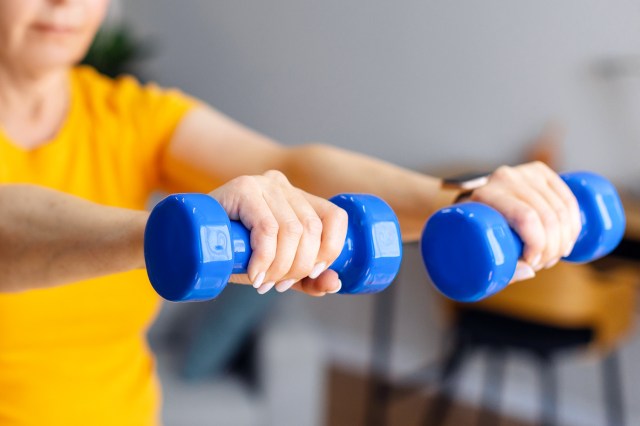We independently evaluate all recommended products and services. If you click on links we provide, we may receive compensation.
For many of us, the hardest part about exercise isn’t the strain on our muscles or lungs — it’s seeking out a routine that’s both effective and sustainable. It can be challenging to find a workout you actually want to stick with that doesn’t take up a lot of time or drain your bank account. So, when digital content creator Lauren Giraldo shared her exercise regimen that promised to check all of these boxes, the online community was quick to listen.
Giraldo first shared her “12-3-30” workout routine on TikTok in late 2020, and it quickly took off. Four years later, it’s more popular than ever. But what exactly do the numbers mean — and does the routine work as well as she says it does?

What Is the 12-3-30 Workout?
After gym culture left her feeling intimidated and discouraged, Giraldo decided to forgo the complicated weight-lifting and Pilates routines and opt for something easier for her to manage. Using a treadmill with an incline function, Giraldo began walking at a level-12 incline at 3 miles per hour for 30 minutes a day — hence the name “12-3-30.”
Giraldo said on social media that she did this routine five days a week, on average, for about two years. “I used to be so intimidated by the gym, and it wasn’t motivating,” she said. “But now I go, I do this one thing, I can feel good about myself, plus I feel like I look snatched. And this is like all I do. I look forward to it. It’s my ‘me’ time.”
In a follow-up TikTok video, Giraldo said it took a couple of months to see noticeable results, and the first major change she observed was in her face. (Overall, she said she lost 30 pounds and got stronger.) She also shared photos of another woman who followed the 12-3-30 workout, and the visible slimming of her stomach and thighs seems to speak for itself. Based on these accounts, it would appear that the 12-3-30 routine does work — but we did a little more digging just to make sure.

Does 12-3-30 Work?
Physical therapist Dr. Douglass Weiss is a major proponent of the 12-3-30 workout. In a YouTube video, he made a case for the viral routine, commending its ability to promote cardiovascular fitness without the same wear and tear on the joints or potential for injury that similar exercises, such as running, can create. Weiss also argued that the 12-3-30 workout is more effective than walking on level ground.
“First of all, the incline reduces the time you need to do the exercise,” he explained. “The incline greatly increases the cardiovascular demand, meaning you get more benefit over a shorter period of time. It’s also much lower impact. Studies have shown that uphill treadmill walking results in much less impact and wear on the knees, hips, and ankles than running at the same cardiac level.” Additionally, Weiss said the shortened duration allows individuals to engage in the exercise routine more often than they might with a long, strenuous workout.
Still, other experts offer a more cautiously optimistic take. Personal trainer and author Saralyn Ward shared her thoughts on the 12-3-30 workout with Healthline, and while she praised the routine for its cardiovascular efficacy, she also offered a warning. “I don’t think you should ever believe that any one workout is the be-all, end-all to your fitness routine or your weight loss goals,” she said. “It’s important to include strength training so that you’re building some muscle and that you can keep those weight loss results up over time.”
Ward also mentioned that sticking to a single activity for weeks, months, or years might increase the likelihood that an individual gets burnt out, bored, or otherwise unmotivated to stick to their routine.

Is the 12-3-30 Workout Safe?
While part of what makes the 12-3-30 workout so popular is how straightforward it is, gradually working your way up to the full incline, speed, and duration can help prevent injury and increase the likelihood that you’ll stick with the regimen for longer. Dr. Weiss suggested using what he called the “talking test” to determine the right speed and incline level for you and to analyze your body’s response to the new routine.
“We want to find an incline and speed where you have difficulty saying five words in a row without taking a breath, but not so hard that you can’t even say two words,” he explained in his video. “If you only have to take a breath at the fourth or fifth word, you’re at the right level.”
One fun trick Dr. Weiss recommended is using the song lyric “Yankee Doodle went to town.” If you’re able to say the entire line in one breath, that’s a sign that your body can handle the current activity level, and it’s safe to up the intensity. If you can say only “Yankee Doodle went to” before you need to stop to take a breath, you should stick to the incline and speed you’re already at.
From there, consistency is key to achieving better cardiovascular health and improved mental well-being. The World Health Organization recommends adults aged 18 to 64 years old do 150 to 300 minutes of moderate-intensity aerobic physical activity or 75 to 150 minutes of vigorous-intensity aerobic physical activity every week. However you choose to reach those goals is up to you.
This article is for general informational purposes only.
Affiliate Disclaimer Medical Disclaimer













 Unique Beauty is free for all users.
Unique Beauty is free for all users.